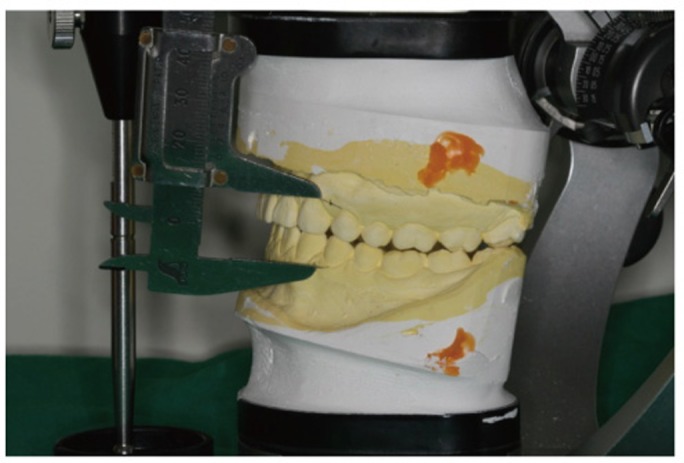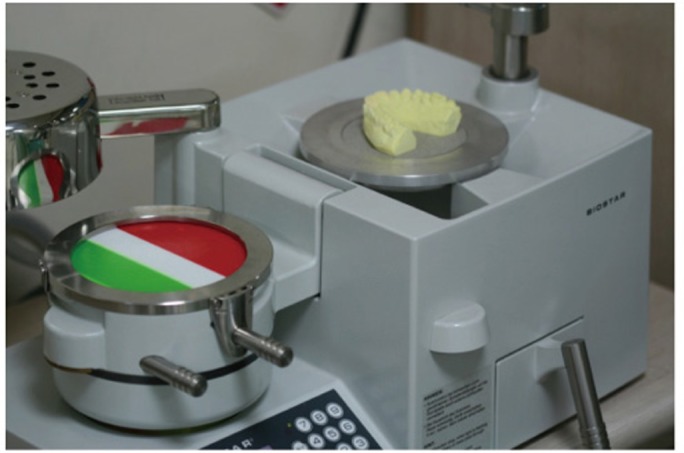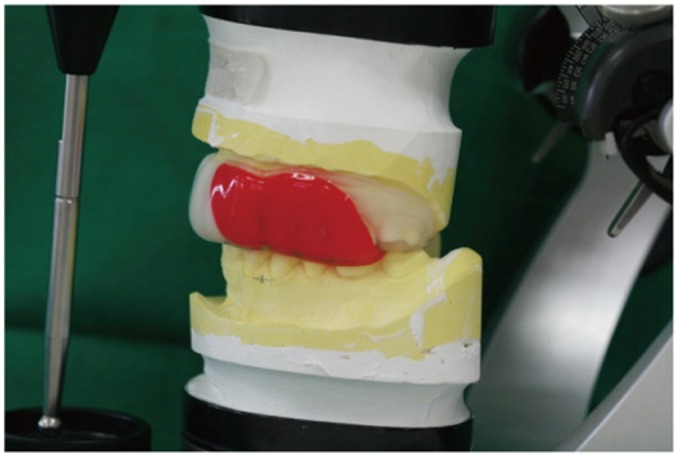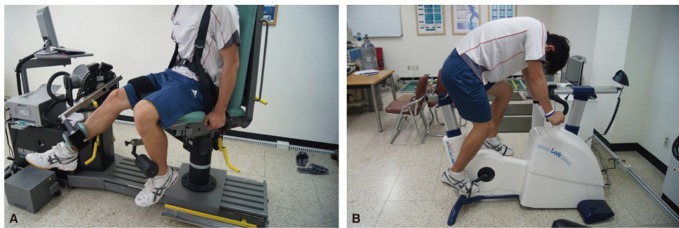J Adv Prosthodont.
2013 Nov;5(4):388-395. 10.4047/jap.2013.5.4.388.
Analysis of the characteristics of mouthguards that affect isokinetic muscular ability and anaerobic power
- Affiliations
-
- 1Department of Oral Medicine, School of Dentistry, Kyungpook National University, Daegu, Republic of Korea.
- 2Department of Prosthodontics, School of Dentistry, Kyungpook National University, Daegu, Republic of Korea. kblee@knu.ac.kr
- 3Department of Physical Education, Teachers College, Kyungpook National University, Daegu, Republic of Korea.
- KMID: 2176526
- DOI: http://doi.org/10.4047/jap.2013.5.4.388
Abstract
- PURPOSE
The purpose of this study was to estimate the effects of occlusal stability to identify action mechanisms of mouthguards, known to have a modulatory effect on limb muscle function.
MATERIALS AND METHODS
This study included 20 male subjects to perform the isokinetic muscle tests and the Wingate anaerobic power test on both knee joints under five closed-mouth conditions: without or with 4 types of mouthguards with thickness of 2 mm based on premolar area: (1) full-coverage, (2) anterior partial-coverage, (3) right posterior partial-coverage, and (4) left posterior partial-coverage. The obtained results were subjected to One-way ANOVA with repeated measures, followed by post hoc test of the contrast method (alpha=.05).
RESULTS
There was no significant difference between the closed position with and without a full-coverage mouthguard in all variables. However, significant differences were observed between with and without a partial-coverage mouthguard in muscular endurance during extension of the left knee, muscular power and endurance during flexion of the right knee. Additionally, significant differences were found between occlusal states with full- and partial-coverage mouthguards in muscular power and endurance during extension of the left knee.
CONCLUSION
These findings indicate the elevation of vertical dimension by 2 mm or the inducement of occlusal stability had little effect on isokinetic muscle strength and anaerobic performance, while uneven distribution of occlusal force might have some positive effects.
Keyword
MeSH Terms
Figure
Reference
-
1. Knapik JJ, Marshall SW, Lee RB, Darakjy SS, Jones SB, Mitchener TA, delaCruz GG, Jones BH. Mouthguards in sport activities:History, physical properties and injury prevention effectiveness. Sports Med. 2007; 37:117–144. PMID: 17241103.2. Geary JL, Clifford TJ, Kinirons MJ. Occlusal accommodation and mouthguards for prevention of orofacial trauma. Oral Health Prev Dent. 2009; 7:55–59. PMID: 19408816.3. Takeda T, Ishigami K, Ogawa T, Nakajima K, Shibusawa M, Shimada A, Regner CW. Are all mouthguards the same and sate to use? The influence of occlusal supporting mouthguards in decreasing bone distortion and fractures. Dent Traumatol. 2004; 20:150–156. PMID: 15144446.4. Takeda T, Ishigami K, Kawamura S, Nakajima K, Shimada A. The influence of impact object characteristics on impact force and force absorption by mouthguard material. Dent Traumatol. 2004; 20:12–20. PMID: 14998410.
Article5. Francis KT, Brasher J. Physiological effects of wearing mouthguards. Br J Sports Med. 1991; 25:227–231. PMID: 1810619.
Article6. Kececi AD, Cetin C, Eroglu E, Baydar ML. Do custom-made mouth guards have negative effects on aerobic performance capacity of athletes? Dent Traumatol. 2005; 21:276–280. PMID: 16149923.
Article7. Duddy FA, Weissman J, Lee RA Sr, Paranjpe A, Johnson JD, Cohence N. Influence of different types of mouthguards on strength and performance of collegiate athletes: a controlled-randomized trial. Dent Traumatol. 2012; 28:263–267. PMID: 22272945.
Article8. von Arx T, Flury R, Tschan J, Buergin W, Geiser T. Exercise capacity in athletes with mouthguards. Int J Sports Med. 2008; 29:435–438. PMID: 17614035.
Article9. Bourdin M, Brunet-Patru I, Hager PE, Allard Y, Hager JP, Lacour JR, Moyen B. Influence of maxillary mouthguards on physiological parameters. Med Sci Sports Exerc. 2006; 38:1500–1504. PMID: 16888465.
Article10. Verban EM Jr, Groppel JL, Pfautsch EW, Ramseyer GC. The effects of mandibular orthopedic repositioning appliance on shoulder strength. J Craniomandibular Pract. 1984; 2:232–237. PMID: 6590657.11. Chakfa AM, Mehta NR, Forgione AG, Al-Badawi EA, Lobo SL, Zawawi KH. The effect of stepwise increases in vertical dimension of occlusion on isometric strength of cervical flexors and deltoid muscles in nonsymptomatic females. Cranio. 2002; 20:264–273. PMID: 12403184.
Article12. Abdallah EF, Mehta NR, Forgione AG, Clark RE. Affecting upper extremity strength by changing maxillo-mandibular vertical dimension in deep bite subjects. Cranio. 2004; 22:268–275. PMID: 15532310.
Article13. Bergamini M, Pierleoni F, Gizdulich A, Bergamini C. Dental occlusion and body posture: A surface EMG study. Cranio. 2008; 26:25–32. PMID: 18290522.
Article14. Milani RS, De Periere DD, Lapeyre L, Pourreyron L. Relationship between dental occlusion and posture. Cranio. 2000; 18:127–134. PMID: 11202823.
Article15. Stenger JM, Lawson EA, Wright JM, Ricketts J. Mouthguards protection against shock to head, neck and teeth. J Am Dent Assoc. 1964; 69:273–281. PMID: 14178758.16. Stenger JM. Physiologic dentistry with Nortre Dame athlets. Basal Facts. 1977; 2:8–18. PMID: 144497.17. Gelb H, Mehta NR, Forgione AG. The relationship between jaw posture and muscular strength in sports dentistry: a reappraisal. Cranio. 1996; 14:320–325. PMID: 9110627.
Article18. Gelb H, Tarte J. A two-year clinical dental evaluation of 200 cases of chronic headache: the craniocervical-mandibular syndrome. J Am Dent Assoc. 1975; 91:1230–1236. PMID: 1059698.
Article19. Gelb H, Bernstein I. Clinical evaluation of two hundred patients with temporomandibular joint syndrome. J Prosthet Dent. 1983; 49:234–243. PMID: 6572263.
Article20. Bates RE Jr, Atkinson WB. The effects of maxillary MORA's on strength and muscle efficiency tests. J Craniomandibular Pract. 1983; 1:37–42. PMID: 6586878.
Article21. Forgione AG, Mehta NR, Westcott WL. Strength and bite, Part 1: An analytical review. Cranio. 1991; 9:305–315. PMID: 1820830.22. Forgione AG, Mehta NR, McQuade CF, Westcott WL. Strength and bite, Part 2: Testing isometric strength using a MORA set to a functional criterion. Cranio. 1992; 10:13–20. PMID: 1302647.23. Kaufman RS. Case reports of TMJ repositioning to improve scoliosis and the performance by athletes. N Y State Dent J. 1980; 46:206–209. PMID: 6928570.24. Kaufman A, Kaufman RS. An experimental study on the effects of the MORA on football players. Funct Orthod. 1985; 2:37–44. PMID: 3861472.25. Allen ME, Walter P, McKay C, Elmajian A. Occlusal splints (MORA) vs. placebos show no difference in strength in symptomatic subjects: double blind/cross-over study. Can J Appl Sport Sci. 1984; 9:148–152. PMID: 6386212.26. McArdle WD, Goldstein LB, Last FC, Spina R, Lichtman S, Meyer JE, Berger AI. Temporomandibular joint repositioning and exercise performance: A double-blind study. Med Sci Sports Exerc. 1984; 16:228–233. PMID: 6748919.27. Abduljabbar T, Mehta NR, Forgione AG, Clark RE, Kronman JH, Munsat TL, George P. Effect of increased maxillo-mandibular relationship on isometric strength in TMD patients with loss of vertical dimension of occlusion. Cranio. 1997; 15:57–67. PMID: 9586489.
Article28. Hanke BA, Motschall E, Türp JC. Association between orthopedic and dental findings: what level of evidence is available? J Orofac Orthop. 2007; 68:91–107. PMID: 17372708.
Article29. Pae A, Yoo RK, Noh K, Paek J, Kwon KR. The effects of mouthguards on the athletic ability of professional golfers. Dent Traumatol. 2013; 29:47–51. PMID: 22386044.
Article30. Williams MO, Chaconas SJ, Bader P. The effect of mandibular position on appendage muscle strength. J Prosthet Dent. 1983; 49:560–567. PMID: 6573505.
Article31. Milani RS, De Periere DD, Lapeyre L, Pourreyron L. Relationship between dental occlusion and posture. Cranio. 2000; 18:127–134. PMID: 11202823.
Article32. Bergamini M, Pierleoni F, Gizdulich A, Bergamini C. Dental occlusion and body posture: A surface EMG study. Cranio. 2008; 26:25–32. PMID: 18290522.
Article33. Goldstein BH, Epstein JB. Unconventional dentistry: Part IV. Unconventional dental practices and products. J Can Dent Assoc. 2000; 66:564–568. PMID: 12584780.34. Smith GH. Occlusal cranial balancing technique. Int J Orthod Milwaukee. 2007; 18:27–33. PMID: 17441619.35. Burkett LN, Bernstein A. The effect of mandibular position on strength, reaction time and movement time on a randomly selected population. N Y State Dent J. 1983; 49:281–285. PMID: 6575323.36. Welch MJ, Edington DM, Ritter RC. Muscular strength and temporomandibular joint repositioning. J Orthop Sports Phys Ther. 1986; 7:236–239. PMID: 18802267.
Article37. Tardieu C, Dumitrescu M, Giraudeau A, Blanc JL, Cheynet F, Borel L. Dental occlusion and postural control in adults. Neurosci Lett. 2009; 450:221–224. PMID: 19070652.
Article38. Shimazaki T, Motoyoshi M, Hosoi K, Namura S. The effect of occlusal alteration and masticatory imbalance on the cervical spine. Eur J Orthod. 2003; 25:457–463. PMID: 14609013.
Article39. D'Attilio M, Filippi MR, Femminella B, Festa F, Tecco S. The influence of an experimentally-induced malocclusion on vertebral alignement in rats: a controlled pilot study. Cranio. 2005; 23:119–129. PMID: 15898568.40. Bracco P, Deregibus A, Piscetta R. Effects of different jaw relations on postural stability in human subjects. Neurosci Lett. 2004; 356:228–230. PMID: 15036636.
Article41. Fujimoto M, Hayakawa I, Hirano S, Watanabe I. Changes in gait stability induced by alteration of mandibular position. J Med Dent Sci. 2001; 48:131–136. PMID: 12160250.42. Rinchuse DJ, McMinn JT. Summary of evidence-based systematic reviews of temporomandibular disorders. Am J Orthod Dentofacial Orthop. 2006; 130:715–720. PMID: 17169733.
Article43. Slavkin HC. Lifetime of motion: temporomandibular joints. J Am Dent Assoc. 1996; 127:1093–1098. PMID: 8754468.
- Full Text Links
- Actions
-
Cited
- CITED
-
- Close
- Share
- Similar articles
-
- An Analysis of Change on Alpine Skiers' Body Composition, Anaerobic Power, and Isokinetic Muscular Function between before and after Winter Season
- A Comparative Study of Eccentric and Concentric Isokinetic Exercise Testing
- Effects of Elastic Resistance Training on Biomechanical Ability in College Taekwondo Athletes
- Comparison between Isokinetic Method and Electromyographic Method in Muscle Power Measurement of Lumbar Muscles
- Analysis of Internal Rotator-External Rotator Muscle of the Shoulder with Cybex II





